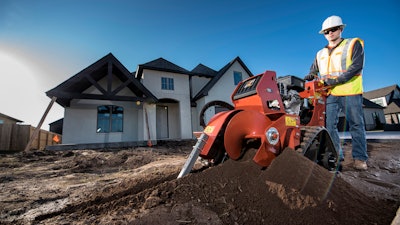
Winter conditions can be harsh in certain parts of the country, but underground construction needs don’t stop just because thermometers begin to display lower numbers. Electrical companies, utility contractors, and even landscapers brave the colder months to get their jobs done.
Trenching is one job we see underground professionals performing year-round. While some machines may require a new set of best practices for operation when working in cold or harsh weather, trenchers operate essentially the same in most conditions.
That said, just like getting ready to work in cold weather requires a few extra steps for workers – putting on warmer clothes, hats, and gloves – trenching in the winter requires more preparation before putting the chain in the ground.
Here are the steps needed to make sure a trencher is winterized and ready to remain productive through the colder months.
Prepare Your Engine and Components
The first step in readying your trencher for winter operation is preparing the engine. Every trencher should have the proper engine oil added for the temperature it will be working in. This will keep the engine performing well and ensure that it stays properly lubricated, even in lower temperatures. Next, manufacturer-recommended service points should be checked, and any moving components should be generously coated with the proper grease before temperatures fall below freezing. At Ditch Witch, we develop our machines without any daily grease points, making daily maintenance a simpler process and giving operators more time to focus on other aspects of machine preparation.
Manufacturer-recommended service intervals should be followed carefully in the winter, and components and fluid levels should be monitored throughout the season to keep the engine and machine components in top operating condition. Ditch Witch service intervals can be be found in the operators’ manual.
Winterize Your Chain
When the air gets cold, the ground does too. Frost can penetrate multiple feet below the surface, making the soil more abrasive and increasing the wear on a trencher chain. In the winter, trenchers should be outfitted with alligator-tooth chains, rather than the standard cup tooth. Alligator-tooth chains rotate to strike a different edge throughout the digging process, lengthening the life of trencher teeth.
Smart contractors will keep new teeth on hand while on a job to make quick repairs and prevent downtime. Operators should also opt for a high-tensile-strength chain, like the Ditch Witch 35K chain, to help cut through difficult frozen ground. When possible, walk-behind trenchers should be the machine of choice in winter conditions.
Warm up the Machine
Warming up your equipment before digging into the ground is very important during the winter months. Running a machine with cold engine oil can lead to engine failure, causing financial and efficiency losses. Hydraulic fluid is also less effective at cold temperatures and must be properly warmed to keep all parts of the machine working smoothly. Contractors should start their machines and let them idle for a few minutes every morning and, when possible, machines should be left above idle throughout the day.
Constantly starting and stopping a machine in cold weather can be harmful to an engine over time. To help protect a machine owner’s investment, Ditch Witch stand-on skid steers are designed with a ‘warm-up mode,’ where engines won’t throttle up into operation until the machine is ready—making them a good option for winter trenching when applied with a trencher attachment.
Another tip for both contractors and machine owners is to store machines inside during the winter. If a trencher isn’t left out in the cold all night, it won’t require as much time for the engine to warm up.
Follow Standard Best Practices
Once a trencher has been prepared for winter work, it’s important to continue following standard trenching best practices. One best practice is letting the trencher and ground conditions determine the pace of work. While it may be tempting to push a machine harder in the name of getting out of the elements quicker, forcing a trencher to move faster can lead to costly machine breakdowns with jobs taking even longer. Keeping a steady pace will protect the machine and help operators get the job done efficiently.
The key to efficient trenching in the winter months is putting in the required work before the job starts. By following these tips, contractors can keep their trenchers running year-round and prevent the cold season from putting a freeze on their business.











![Doosan Bobcat Wacker Neuson Stack 2ec Js Pb V6e[1]](https://img.greenindustrypros.com/mindful/acbm/workspaces/default/uploads/2025/12/doosan-bobcat-wacker-neuson-stack2ecjspbv6e1.CPyyz8ubHn.png?ar=16%3A9&auto=format%2Ccompress&bg=fff&fill-color=fff&fit=fill&h=135&q=70&w=240)








